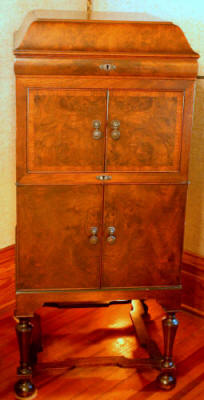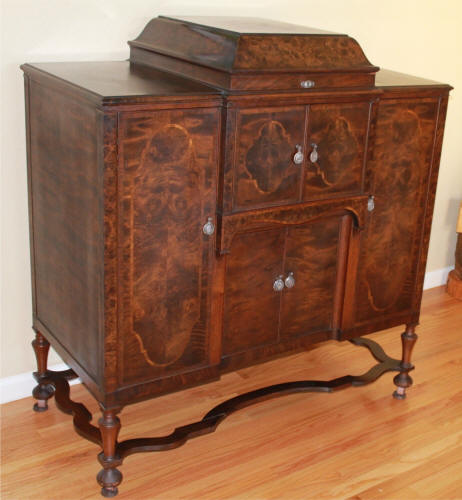
The Victor-Victrola Page
 Victor
Period Models "William and Mary"
Victor
Period Models "William and Mary"
RARITY: ¤¤¤¤ VALUE: ¤¤¤¤

Some Background on "Period" Victrolas
Period Victrolas were semi-custom models featuring
Victor's best designs, veneers and craftsmanship. These expensive, special-order
phonographs were first introduced as upright-only styles in the spring of 1917, and were
continued through 1924. Production volumes were very limited. Manufacture of
these models was totally curtailed during World War I (mid-1917 through the end
of 1918), and when they were re-introduced in 1919, virtually all phonograph
makers had launched their own upscale products, and the Period Models became
less exclusive and appealing to the buying public.
Period Victrolas used
names of period furniture designers or styles, typically dating from the 18th
and 19th centuries, along with a designator number to indicate slight variations
in design. For example, the "Adam" Period Victrolas (named after architect James
Adam) were originally sold in 6 design variations, starting with "Adam No. 0"
through "Adam No. 5". The serial numbers (each variation was serialized
independently) always started at 501. Some variations were discontinued or
changed during the production run. In 1920, Victor introduced horizontal
console-style Period Victrolas as an addition to the upright Period product
line, with similar nomenclature. The console models are much larger overall,
with a squared-off "boxy" design which was not very popular. Console
model variations are typically designed as a "Type 500" or "501" on the
dataplate. As with the standard Victrola models, Period Victrolas were produced
in both hand-wound and electric (VE) versions. Prices ranged from $300 to well
over $1200 depending on finish and model. It is estimated that no more than 50
of each unique design variation (e.g. Adam No. 0) were produced; based on the serial
numbers of surviving examples, actual production was probably less than 25 of
each variation. It is also possible that some of the variations which appeared in
the catalogs were never put into production. Period Models are amongst the rarest
Victrolas; however, the simpler examples will not typically command top prices,
as they are often very similar in design to standard production models.
These pricey Victrolas did not sell well, and were highly discounted in the mid-1920's. Many were shipped from dealer-to-dealer for short-term display purposes, and ended-up being sold as "used" machines. Surviving documentation implies that most were actually sold when prices were cut in half during the summer of 1925.


The
William and Mary Period models took their design cues from
Flemish, Dutch and French influences in furniture styling, characterized
by linear features and distinctive turnings on the legs and base.
Most were produced in mahogany, often with walnut or exotic wood inlays.
At least 4 different variations were produced in upright designs (Wm and Mary
No. 0 through Wm and Mary No. 3), ranging in price from $350.00 to $600.00. A
"Wm and Mary No 3" upright is shown at left. At least one design variation
was also produced in the console style (right), denoted as "Wm and Mary 500",
which retailed for $1165.00 in spring-wound and $1200.00 in electric powered
versions.
This equates to over $17,000.00
in today's money.
The survival database currently shows 8 existing "William and Mary" Models, both in the wide-body console and upright styles. All William and Mary console models that have been verified to date have "No. 500" designations. Upright models have been documented in only the "No. 0" and "No. 3" variations.
Do you own a Victrola William and Mary model? Please take a moment and enter some basic information about your machine into the collector's database by clicking here. No personal information is required.